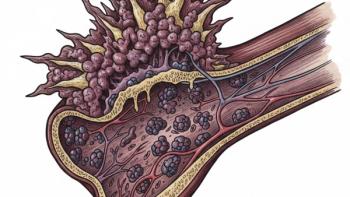
Combined Modality Treatment May Be OK as First Course of Treatment for Muscle-Invasive Bladder Cancer
Combined modality treatment (CMT) could be considered a first course of treatment for patients with muscle-invasive bladder cancer, according to the authors of a recent study published in the International Journal of Radiation Oncology.
Combined modality treatment (CMT) could be considered a first course of treatment for patients with muscle-invasive bladder cancer, according to the authors of a recent study published in the International Journal of Radiation Oncology.
Currently, radical cystectomy (RC) — the removal of the entire bladder and nearby lymph nodes — is standard of care. CMT is the combination of radiation therapy, chemotherapy and the removal of the bladder tumor. However, researchers found no difference in five-year and 10-year survival rates between patients.
“These results provide compelling evidence suggesting radiation therapy may be as good as surgery for many of these patients,” senior author Dharam Kaushik, M.D., assistant professor at UT Health San Antonio and the UT Health Cancer Center, said in a statement. He added, “According to our analyses, patients undergoing radical cystectomy likely share no cancer survival benefits compared with patients receiving chemoradiation-based bladder preservation therapy.”
The meta-analysis was performed using previously published cancer research from seven databases. Researchers examined overall survival (OS), disease-specific survival (DSS), progression-free survival (PFS) and treatment-related complications between RC and CMT.
Researchers reviewed 19 studies and evaluated 12,380 patients. Only eight of the studies were eligible for meta-analysis, which included 9,554 patients.
They found no difference in OS or DSS at five years or 10 years’ post-treatment. And, at 10 years’ post-treatment they found no difference in PFS. The authors noted that there were no studies that examined PFS at five years’ post-treatment.
In addition, the RC arms had higher rates of early major complications. Minor complications were similar between RC and CMT.
Challenges associated with RC include sexual side effects for men and women, risk of blot clots, bleeding, infection and damage to nearby organs. Since the whole bladder is removed, it requires patients to undergo an additional surgery that will help with storage of urine, either inside or outside of the body.
Often turned to as a secondary treatment for patients who are not healthy enough for RC, CMT requires close coordination and careful preparation to minimize side effects.
Bladder cancer is the sixth most common cancer in the United States. Muscle-invasive disease is more likely to spread to other parts of the body that non-muscle invasive disease and therefore is treated more aggressively. Also, it is more likely to occur in high-grade cancers.
“We hope this study will help patients and their physicians understand the full range of options available when planning treatment for muscle-invasive bladder cancer,” said Kaushik.
The authors said that further research is needed to evaluate the two treatment arms, which Kaushik and his team already have in the works. They are currently enrolling patients in a pilot study where 30 patients with muscle-invasive bladder cancer will be divided in half, one group to be treated with RC and the other with CMT.





